Ramen
 Shōyu (soy-based broth) ramen[1] | |
| Alternative names | shina soba, chūka soba |
|---|---|
| Type | Noodle soup |
| Place of origin | Japan[2][3][4] |
| Serving temperature | Hot |
| Main ingredients | Chinese wheat noodles, meat- or fish-based broth, vegetables or meat |
| Variations | Many variants, especially regional, with various ingredients and toppings |
| |
Ramen (/ˈrɑːmən/) (拉麺, ラーメン, rāmen, IPA: [ɾaꜜːmeɴ]) is a Japanese dish. It consists of Chinese-style wheat noodles[5] served in a meat or (occasionally) fish-based broth, often flavored with soy sauce or miso, and uses toppings such as sliced pork (叉焼, chāshū), dried seaweed (海苔, nori), menma (麺麻), and green onions (葱, negi). Nearly every region in Japan has its own variation of ramen, such as the tonkotsu (pork bone broth) ramen of Kyushu and the miso ramen of Hokkaido.[6][7]
Contents
1 History
1.1 Origin
1.2 Etymology
1.3 Initial appearance
1.4 Postwar popularization
1.5 Modern period
2 Types
2.1 Noodles
2.2 Soup
2.3 Flavors
2.4 Toppings
2.5 Preference
3 Regional variations
4 Related dishes
5 Restaurants in Japan
6 Outside Japan
6.1 Instant ramen
7 Museum
8 Canned version
9 See also
10 Notes
11 Further reading
12 External links
History
Origin
Ramen is a Japanese adaptation of Chinese wheat noodles.[5][8][9][10][11] Ramen was first introduced to Japan by Chinese immigrants in the late 19th[12][5] or early 20th century.[13][14] According to the record of the new Yokohama Ramen Museum, ramen originated in China and made its way over to Japan in 1859.[12] Early versions were wheat noodles in broth topped with Chinese-style roast pork.[5]
Etymology
The word ramen is a Japanese transcription of the Chinese lamian (拉麵).[15][16] In 1910, a Chinese restaurant serving ramen in Yokohama's Chinatown received public praise in Japan.[17][18] Until the 1950s, ramen was called shina soba (支那そば, literally "Chinese soba") but today chūka soba (中華そば, also meaning "Chinese soba") or just ramen (ラーメン) are more common, as the word "支那" (shina, meaning "China") has acquired a pejorative connotation.[4]
Initial appearance
By 1900, restaurants serving Chinese cuisine from Canton and Shanghai offered a simple ramen dish of noodles (cut rather than hand-pulled), a few toppings, and a broth flavored with salt and pork bones. Many Chinese living in Japan also pulled portable food stalls, selling ramen and gyōza dumplings to workers. By the mid-1900s, these stalls used a type of a musical horn called a charumera (チャルメラ, from the Portuguese charamela) to advertise their presence, a practice some vendors still retain via a loudspeaker and a looped recording. By the early Shōwa period, ramen had become a popular dish when eating out.[citation needed]
According to ramen expert Hiroshi Osaki, the first specialized ramen shop opened in Yokohama in 1910.[10]
Postwar popularization
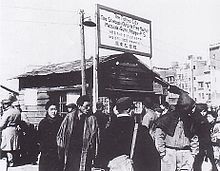
A postwar Japanese Black market in Shinbashi, 1946
After Japan's defeat in World War II, the American military occupied the country from 1945 to 1952.[5] In December 1945, Japan recorded its worst rice harvest in 42 years,[5][19] which caused food shortages as Japan had drastically reduced rice production during the war as production shifted to colonies in China and Taiwan.[5] The US flooded the market with cheap wheat flour to deal with food shortages.[5] From 1948 to 1951, bread consumption in Japan increased from 262,121 tons to 611,784 tons,[5] but wheat also found its way into ramen, which most Japanese ate at black market food vendors to survive as the government food distribution system ran about 20 days behind schedule.[5] Although the Americans maintained Japan's wartime ban on outdoor food vending,[5] flour was secretly diverted from commercial mills into the black markets,[5] where nearly 90 percent of stalls were under the control of gangsters locally referred to as yakuza who extorted vendors for protection money.[5] Thousands of ramen vendors were arrested during the occupation.[5] In the same period, millions of Japanese troops returned from China and continental East Asia from their posts in the Second Sino-Japanese War. Some of them would have been familiar with wheat noodles.[5] By 1950 wheat flour exchange controls were removed and restrictions on food vending loosened, which further boosted the number of ramen vendors: private companies even rented out yatai starter kits consisting of noodles, toppings, bowls, and chopsticks.[5] Ramen yatai provided a rare opportunity for small scale postwar entrepreneurship.[5] The Americans also aggressively advertised the nutritional benefits of wheat and animal protein.[5] The combination of these factors caused wheat noodles to gain prominence in Japan's rice-based culture.[5] Gradually, ramen became associated with urban life.[5]
Modern period
In 1958, instant noodles were invented by Momofuku Ando, the Taiwanese-Japanese founder and chairman of Nissin Foods. Named the greatest Japanese invention of the 20th century in a Japanese poll,[20] instant ramen allowed anyone to make an approximation of this dish simply by adding boiling water.
Beginning in the 1980s, ramen became a Japanese cultural icon and was studied around the world from many perspectives. At the same time, local varieties of ramen were hitting the national market and could even be ordered by their regional names. A ramen museum opened in Yokohama in 1994.[21]
Today ramen is arguably one of Japan's most popular foods, with Tokyo alone containing around 5,000 ramen shops,[5] and more than 24,000 ramen shops across Japan.[22]Tsuta, a ramen restaurant in Tokyo’s Sugamo district, received a Michelin star in December 2015.[22]
Types
A wide variety of ramen exists in Japan, with geographical and vendor-specific differences even in varieties that share the same name. Ramen can be broadly categorized by its two main ingredients: noodles and broth.
Noodles
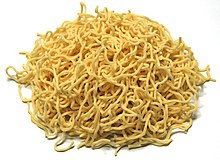
Fresh ramen
Most noodles are made from four basic ingredients: wheat flour, salt, water, and kansui (かん水) (from kansui (鹹水, salt water)) a type of alkaline mineral water, containing sodium carbonate and usually potassium carbonate, as well as sometimes a small amount of phosphoric acid.
The kansui is the distinguishing ingredient in ramen noodles, and originated in Inner Mongolia, where some lakes contained large amounts of these minerals and whose water is said to be perfect for making these noodles. Making noodles with kansui lends them a yellowish hue as well as a firm texture. Eggs may also be substituted for kansui. Some noodles are made with neither eggs nor kansui and should only be used for yakisoba, as they have a weaker structure and are more prone to soaking up moisture and becoming extremely soft when served in soup.
Ramen comes in various shapes and lengths. It may be thick, thin, or even ribbon-like, as well as straight or wrinkled.
Soup

Ramen in tonkotsu soup
Ramen soup is generally made from stock based on chicken or pork, combined with a variety of ingredients such as kombu (kelp), katsuobushi (skipjack tuna flakes), niboshi (dried baby sardines), beef bones, pork bones, shiitake, and onions. Some modern Ramen broths can also be vegetable based.
Tonkotsu (豚骨, "pork bone"; not to be confused with tonkatsu) soup usually has a cloudy white colored broth. It is similar to the Chinese baitang (白湯) and has a thick broth made from boiling pork bones, fat, and collagen over high heat for many hours, which suffuses the broth with a hearty pork flavor and a creamy consistency that rivals milk, melted butter or gravy (depending on the shop).
Flavors

Shoyu ramen
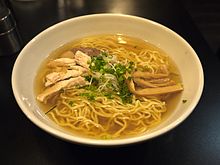
Shio ramen

Miso ramen

Curry ramen
The resulting combination is generally divided into four categories. (although new and original variations often make this categorization less clear-cut) Described from old ones.
Shōyu (醤油, "soy sauce") ramen is the oldest of the four, it has a clear brown broth, based on a chicken and vegetable (or sometimes fish or beef) stock with plenty of soy sauce added resulting in a soup that is tangy, salty, and savory yet still fairly light on the palate. Shōyu ramen usually has curly noodles rather than straight ones, but this is not always the case. It is often adorned with marinated bamboo shoots or menma, green onions, kamaboko (fish cakes), nori (seaweed), boiled eggs, bean sprouts or black pepper; occasionally the soup will also contain chili oil or Chinese spices, and some shops serve sliced beef instead of the usual chāshū.
Shio (塩,"salt") ramen is a pale, clear, yellowish broth made with plenty of salt and any combination of chicken, vegetables, fish, and seaweed. Occasionally pork bones are also used, but they are not boiled as long as they are for tonkotsu ramen, so the soup remains light and clear. Chāshū is sometimes swapped for lean chicken meatballs, and pickled plums and kamaboko (a slice of processed fish roll sometimes served as a frilly white circle with a pink or red spiral called narutomaki) are popular toppings as well. Noodle texture and thickness varies among shio ramen, but they are usually straight rather than curly.
Miso (味噌) ramen is a relative newcomer, having reached national prominence around 1965. This uniquely Japanese ramen, which was developed in Hokkaido, features a broth that combines copious miso and is blended with oily chicken or fish broth – and sometimes with tonkotsu or lard – to create a thick, nutty, slightly sweet and very hearty soup. Miso ramen broth tends to have a robust, tangy flavor, so it stands up to a variety of flavorful toppings: spicy bean paste or tōbanjan (豆瓣醤), butter and corn, leeks, onions, bean sprouts, ground pork, cabbage, sesame seeds, white pepper, and chopped garlic are common. The noodles are typically thick, curly, and slightly chewy.
Curry (カレー) ramen was first created in 1965 in Hokkaido.[23] The soup is mainly made with pork bones and vegetables and is seasoned with curry. The noodles are thick and curly. Toppings include chāshū, wakame, and bean sprouts. It is a specialty of Hokkaido, particularly Muroran-city (hence sometimes being called "Muroran curry ramen").
Toppings
After basic preparation, ramen can be seasoned and flavored with any number of toppings,[24] including but not limited to:
Chāshū (sliced barbecued or braised pork)
Scallions (spring onions)- Seasoned (usually salted) boiled egg
Bean or other sprouts
Menma (lactate-fermented bamboo shoots)
Kakuni (braised pork cubes or squares)
Nori (dried seaweed)
Narutomaki/kamaboko (formed fish paste)- Corn
- Butter
- Wakame
- Crispy duck
Preference
Seasonings commonly added to ramen are white pepper, black pepper, butter, chili pepper, sesame seeds, and crushed garlic. Soup recipes and methods of preparation tend to be closely guarded secrets.
Most tonkotsu ramen restaurants offer a system known as kae-dama (替え玉), where customers who have finished their noodles can request a "refill" (for a few hundred yen more) to be put into their remaining soup.[25]
Regional variations
While standard versions of ramen are available throughout Japan since the Taisho era, the last few decades have shown a proliferation of regional variations. Some of these which have gone on to national prominence are:
Sapporo, the capital of Hokkaido, is especially famous for its ramen. Most people in Japan associate Sapporo with its rich miso ramen, which was invented there and which is ideal for Hokkaido's harsh, snowy winters. Sapporo miso ramen is typically topped with sweetcorn, butter, bean sprouts, finely chopped pork, and garlic, and sometimes local seafood such as scallop, squid, and crab. Hakodate, another city of Hokkaido, is famous for its salt flavored ramen,[26] while Asahikawa in the north of the island offers a soy sauce-flavored variation.[27] In Muroran, many ramen restaurants offer Muroran curry ramen.[28]
Kitakata in northern Honshu is known for its rather thick, flat, curly noodles served in a pork-and-niboshi broth. The area within its former city boundaries has the highest per-capita number of ramen establishments. Ramen has such prominence in the region that locally, the word soba usually refers to ramen, and not to actual soba which is referred to as nihon soba ("Japanese soba").
Tokyo style ramen consists of slightly thin, curly noodles served in a soy-flavored chicken broth. The Tokyo style broth typically has a touch of dashi, as old ramen establishments in Tokyo often originate from soba eateries. Standard toppings are chopped scallion, menma, sliced pork, kamaboko, egg, nori, and spinach. Ikebukuro, Ogikubo and Ebisu are three areas in Tokyo known for their ramen.
Yokohama ramen specialty is called Ie-kei (家系). It consists of thick, straight-ish noodles served in a soy flavored pork broth similar to tonkotsu. The standard toppings are roasted pork (chāshū), boiled spinach, sheets of nori, often with shredded Welsh onion (negi) and a soft or hard boiled egg. It is traditional for customers to call the softness of the noodles, the richness of the broth and the amount of oil they want.
Wakayama ramen in the Kansai region has a broth made from soy sauce and pork bones.[29]
Hakata ramen originates from Hakata district of Fukuoka city in Kyushu. It has a rich, milky, pork-bone tonkotsu broth and rather thin, non-curly and resilient noodles. Often, distinctive toppings such as crushed garlic, beni shōga (pickled ginger), sesame seeds, and spicy pickled mustard greens (karashi takana) are left on tables for customers to serve themselves. Ramen stalls in Hakata and Tenjin are well-known within Japan. Recent trends have made Hakata ramen one of the most popular types in Japan, and several chain restaurants specializing in Hakata ramen can be found all over the country.

Tokyo-style ramen

Kitakata ramen

Hakata ramen with tonkotsu soup

Wakayama ramen
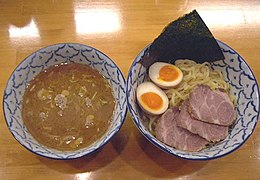
Tsukemen dipping ramen

Aburasoba oiled noodles
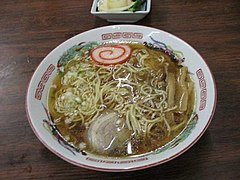
Takayama ramen
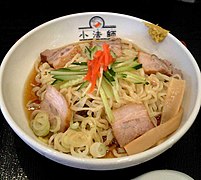
Hiyashi (chilled) ramen
Butter corn ramen, a Hokkaido speciality

Sapporo-style ramen
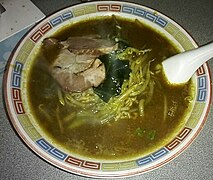
Muroran curry ramen
Related dishes
There are a number of related, Chinese-influenced noodle dishes in Japan. The following are often served alongside ramen in ramen establishments. They do not include noodle dishes considered traditionally Japanese, such as soba or udon, which are almost never served in the same establishments as ramen.
Nagasaki champon. The noodles are thicker than ramen but thinner than udon. Champon is topped with a variety of ingredients, mostly seafood, stir-fried and dressed in a starchy sauce. The stir-fried ingredients are poured directly over the cooked noodles, with the sauce acting as a soup.
Tan-men is a mild, usually salt tasted soup, served with a mix of sauteed vegetables and seafood/pork. Not to be confused with the tantan-men (see after).
Wantan-men has long straight noodles and wonton, served in a mild, usually salt tasted soup.
Abura soba ("oil-noodles"). Essentially ramen and toppings served without the soup, but with a small quantity of oily soy-based sauce instead.
Tsukemen ("dipping noodles"). The noodles and soup are served in separate bowls. The diner dips the noodles in the soup before eating. Can be served hot or chilled.
Tantan-men (担担麺). Japanese version of dan dan noodles, a Sichuan specialty. Ramen in a reddish, spicy chili and sesame soup, usually containing minced pork, garnished with chopped scallion and chili and occasionally topped with the likes of spinach or Bok Choi (chingensai).
Sūrātanmen or sanrātanmen (酸辣湯麺, "noodles in hot and sour soup") is very similar to Sichuan hot and sour soup served with long noodles. The topping ingredients are sauteed and a thickener is added, before the mix is poured on the soup and the noodles.
Hiyashi-chūka (冷やし中華, "chilled Chinese"). Also known as reimen, esp. in western Japan. A summer dish of chilled ramen on a plate with various toppings (typically thin strips of omelette, ham, cucumber and tomato) and served with a vinegary soy dressing and karashi (Japanese mustard). It was first produced at the Ryutei, a Chinese restaurant in Sendai.
Restaurants in Japan

A ramen restaurant in central Kyoto
Ramen is offered in various types of restaurants and locations including ramen shops, izakaya drinking establishments, lunch cafeterias, karaoke halls, and amusement parks. However, the best quality ramen is usually only available in specialist ramen-ya restaurants.
As ramen-ya restaurants offer mainly ramen dishes, they tend to lack variety in the menu. Besides ramen, some of the dishes generally available in a ramen-ya restaurant include fried rice (called Chahan or Yakimeshi), gyoza (Chinese dumplings), and beer.

Ramen in Republic of Korea
Outside Japan

Shio ramen from a Southern California ramen restaurant
Ramen became popular in China, Hong Kong, and Taiwan where it is known as rìshì lāmiàn (日式拉麺, lit. "Japanese-style lamian"). Restaurant chains serve ramen alongside distinctly Japanese dishes, such as tempura and yakitori. Interestingly, in Japan, these dishes are not traditionally served with ramen, but gyoza, kara-age and others from Japanese Chinese cuisine.
In Korea, ramen is called ramyeon (라면 / 拉麺). There are different varieties, such as kimchi-flavored ramyeon. While usually served with vegetables such as carrots and green onions, or eggs, some restaurants serve variations of ramyeon containing additional ingredients such as dumplings, tteok, or cheese as topping.[30]
Outside of Asia, there are restaurants specialising in Japanese-style foods like ramen noodles, especially in areas with a large demand for Asian cuisine. For example, Wagamama, a UK-based restaurant chain serving pan-Asian food, serves a ramen noodle soup. Jinya Ramen Bar serves tonkotsu ramen in the United States and Canada.
Instant ramen
Instant ramen noodles were exported from Japan by Nissin Foods starting in 1971, bearing the name "Oodles of Noodles".[31] One year later, it was re-branded "Nissin Cup Noodles", packaged in a foam food container (It is referred to as Cup Ramen in Japan), and subsequently saw a growth in international sales. Over time, the term "ramen" became used in North America to refer to other instant noodles. While some research has claimed that consuming instant ramen two or more times a week increases the likelihood of developing heart disease and other conditions, including diabetes and stroke, especially in women, those claims have not been reproduced and no study has isolated instant ramen consumption as an aggravating factor.[32][33]
Museum
The Shin-Yokohama Raumen Museum is a unique museum about ramen, located in the Shin-Yokohama district of Kōhoku-ku, Yokohama.[34]
Canned version
In Akihabara, vending machines distribute warm ramen in a steel can, known as ramen kan (らーめん缶). It is produced by a popular ramen restaurant and contains noodles, soup, menma, and pork. It is intended as a quick snack, and includes a small folded plastic fork. There are few kinds of flavor such as tonkotsu and curry.[35]
See also
- List of Japanese soups and stews
- List of noodle dishes
- List of ramen dishes
- List of soups
- Lo mein
- Pot Noodle
- Hawaiian saimin
- Shirataki noodles
Notes
^ 西山製麺 ラーメンワンダーランド「ラーメン丼の図柄の意味は?」
^ "Ramen". Dictionary.com Unabridged. Random House. Retrieved 2013-09-26..mw-parser-output cite.citation{font-style:inherit}.mw-parser-output q{quotes:"""""""'""'"}.mw-parser-output code.cs1-code{color:inherit;background:inherit;border:inherit;padding:inherit}.mw-parser-output .cs1-lock-free a{background:url("//upload.wikimedia.org/wikipedia/commons/thumb/6/65/Lock-green.svg/9px-Lock-green.svg.png")no-repeat;background-position:right .1em center}.mw-parser-output .cs1-lock-limited a,.mw-parser-output .cs1-lock-registration a{background:url("//upload.wikimedia.org/wikipedia/commons/thumb/d/d6/Lock-gray-alt-2.svg/9px-Lock-gray-alt-2.svg.png")no-repeat;background-position:right .1em center}.mw-parser-output .cs1-lock-subscription a{background:url("//upload.wikimedia.org/wikipedia/commons/thumb/a/aa/Lock-red-alt-2.svg/9px-Lock-red-alt-2.svg.png")no-repeat;background-position:right .1em center}.mw-parser-output .cs1-subscription,.mw-parser-output .cs1-registration{color:#555}.mw-parser-output .cs1-subscription span,.mw-parser-output .cs1-registration span{border-bottom:1px dotted;cursor:help}.mw-parser-output .cs1-hidden-error{display:none;font-size:100%}.mw-parser-output .cs1-visible-error{font-size:100%}.mw-parser-output .cs1-subscription,.mw-parser-output .cs1-registration,.mw-parser-output .cs1-format{font-size:95%}.mw-parser-output .cs1-kern-left,.mw-parser-output .cs1-kern-wl-left{padding-left:0.2em}.mw-parser-output .cs1-kern-right,.mw-parser-output .cs1-kern-wl-right{padding-right:0.2em}
^ "Definition of "ramen"". The Collins American English Dictionary. Collins. Retrieved 2013-09-26.
^ ab Cwiertka, Katarzyna Joanna (2006). Modern Japanese cuisine: food, power and national identity. Reaktion Books. p. 144. ISBN 1-86189-298-5.However, Shina soba acquired the status of 'national' dish in Japan under a different name - rāmen. The change of name from Shina soba to rāmen took place during the 1950s and '60s. The word Shina, used historically in reference to China, acquired a pejorative connotation through its association with Japanese imperialist association in Asia and was replaced with the word Chūka, which derived from the Chinese name for the People's Republic. For a while, the term Chūka soba was used, but ultimately the name rāmen caught on, inspired by the chicken-flavored instant version of the dish that went on sale in 1958 and spread nationwide in no time.
^ abcdefghijklmnopqrstu "How Did Ramen Become Popular?". Atlas Obscura. 2018.
^ 大辞林(Yahoo!辞書) Archived 4 August 2009 at the Wayback Machine. 大辞泉(goo辞書)、日本大百科全書(Yahoo!百科事典) Archived 19 April 2017 at the Wayback Machine. の「ラーメン」項より。
^ 石神秀幸『ラーメンの真髄』、ベスト新書、KKベストセラーズ、2007年、
ISBN 978-4-584-12154-2
^ Rupelle, Guy de la (2005). Kayak and land journeys in Ainu Mosir: Among the Ainu of Hokkaido. Lincoln, NE: iUniverse. p. 116. ISBN 978-0-595-34644-8.
^ Asakawa, Gil (2004). Being Japanese American. Berkeley, CA: Stone Bridge Press. p. 49. ISBN 978-1-880656-85-3.
^ ab NHK World. Japanology Plus: Ramen. 2014. Accessed 2015-03-08.
^ Okada, Tetsu (2002). ラーメンの誕生 [The birth of Ramen] (in Japanese). Chikuma Shobō. ISBN 448005930X.
^ ab Shin-Yokohama Raumen Museum
^ Okuyama, Tadamasa (2003). 文化麺類学・ラーメン篇 [Cultural Noodle-logy;Ramen] (in Japanese). Akashi Shoten. ISBN 4750317926.
^ Kosuge, Keiko (1998). にっぽんラーメン物語 [Japanese Ramen Story] (in Japanese). Kodansha. ISBN 4062563029.
^ Unearth the secrets of ramen at Japan's ramen museum
^ Kodansha encyclopedia of Japan, Volume 6 (1st ed.). Tokyo: Kodansha. 1983. p. 283. ISBN 978-0-87011-626-1.
^ Japanese ramen secret history "Nikkei Sangyo Shimbun premium series,(in Japanese). 『日本ラーメン秘史』日経プレミアムシリーズ、2011
^ 新横浜ラーメン博物館「日本のラーメンの歴史」
^ Griffiths, Owen (29 August 2018). "Need, Greed, and Protest in Japan's Black Market, 1938-1949". Journal of Social History. Retrieved 29 August 2018.
^ "Japan votes noodle the tops". BBC News. 2000-12-12. Retrieved 2007-04-25. BBC News
^ Japanorama, Series 3, Episode 4. BBC Three, 9 April 2007
^ ab Demetriou, Danielle (23 February 2016). "The holy grail of ramen dishes". BBC Travel. Retrieved 26 August 2018.
^ Adventures in ramen: Japan's ever-changing soup scene CNN Travel-February 10, 2015
^ ラーメンの具、トッピング選手権 [Ramen ingredient and topping ranking]. Oricon Style (in Japanese). Oricon, Inc.
^ "Hakata Ramen (Nagahama Ramen) FAQ". Mukai.dameningen.org. Archived from the original on 1 April 2012. Retrieved 18 November 2012.
^ Nate (2009-12-17). "函館らーめん大門 (Hakodate Ramen Daimon)". Ramenate!. Retrieved 2012-11-18.
^ "Asahikawa Travel: Asahikawa Ramen". japan-guide.com. Retrieved 2013-09-26.
^ 加盟店一覧 (50音順) (2013-01-24). "室蘭カレーラーメンの会 » 北海道ラーメン第4の味を目指して・・・". Muroran-curryramen.com. Retrieved 2015-09-28.
^ Hiufu Wong, Maggie (2013-06-07). "10 things that make Wakayama Japan's best kept secret". CNN Travel. Cable News Network. Turner Broadcasting System, Inc. Retrieved 2014-11-22.
^ Back to Korean-Style Ramyeon at Nenassi's Noodle Bar
^ "Inventor of instant noodles dies" BBC News. 6 January 2007
^ "Harvard Study Reveals Just How Much Damage Instant Noodles Do to Your Body". Snopes.com. 2016-07-06. Retrieved 2017-03-03.
^ "Health Column: The risks behind those ramen noodles". Retrieved 2016-01-31.
^ "Ramen Museum". Retrieved 2008-06-18.
^ "Ramen-can: a topic in Akihabara". Archived from the original on 2008-07-24. Global Pop Culture
Further reading
Orkin, Ivan (2013). Ivan Ramen: Love, Obsession, and Recipes from Tokyo's Most Unlikely Noodle Joint. Berkeley, Calif.: Ten Speed Press. ISBN 9781607744467. OCLC 852399997. Retrieved 7 April 2014.
"The art of the slurp (or, How to eat ramen)". The Splendid Table. 4 April 2014. Retrieved 7 April 2014. Interview with the author.










